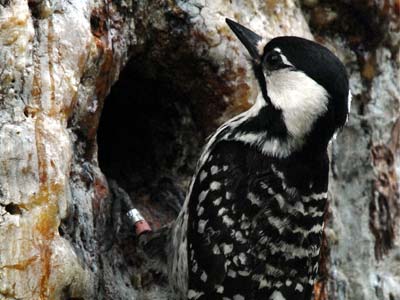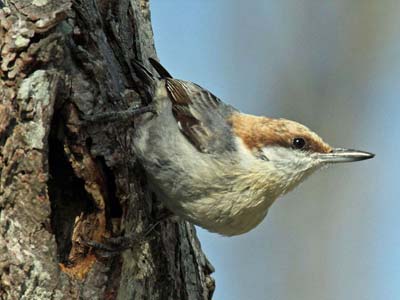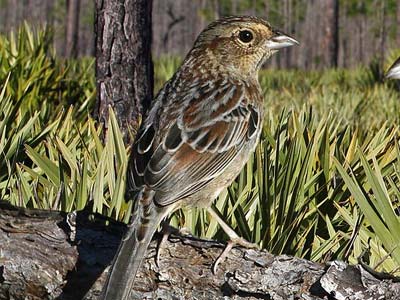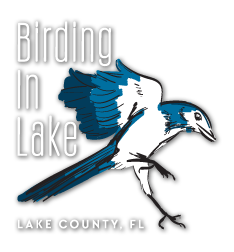Lake County Notable Birds

Florida Scrub-jay
Aphelocoma coerulescens
13” Wingspan: 17” Weight: 4.1oz. (116g.)
Federally Threatened
Xeric Scrub, Coastal Scrub, & Oak-Pine Scrub that is periodically burned resulting in a mosaic of trees 3-15’ tall
Acorns, Insects, Small Reptiles, Small Mammals, Seeds, Berries
Florida Endemic. Largest Populations occur in Ocala NF, Merritt Island NWR, Lake Whales Ridge, and Coastal Scrub along the central Gulf Coast
Identical, Juveniles have mousy brown head and back from March-August, after that they look like adults.
Social family structure in which previous years young with act as “helpers” to breeding pair to raise young. In fall they will “cash” acorns to consume during the early spring when food is most difficult to find. Family units will defend a territory of 15-25 acres depending on quality of habitat. Family units consist of a breeding pair and up to 6 “helpers” from previous broods.
Sedentary, post breeding dispersal of 2nd and 3rd year birds up to 7 miles is typical, but movements over 20 miles have occurred.
Low raspy kreesh, harsh kereep, and a hiccup given ONLY by females.

Red-cockaded Woodpecker
Picoides borealis
8.5” Wingspan: 14” Weight: 1.5oz. (44g.)
Federally Critically Endangered
Old growth pinewoods, usually dominated by Long-leaf Pine and burned frequently to prevent heavy hardwood and tall understory from forming.
Primarily insects but will supplement with fruits, nuts, and seeds.
From South Central Florida north to Southern New Jersey (Now Extirpated) and west to Texas and Missouri.
Sexes are dimorphic with the male showing a red “cockaded” at the upper-rear edge of the white cheek. Juveniles look similar to adults but often show a red patch on the head.
Cooperative breeder with pairs often remaining together for several years. Younger birds will assist in raising young and defending territory of the breeding pair. Nest is built exclusively in live old growth pines, unlike most woodpeckers which nest in dead trees.
Sedentary, post breeding dispersal of 2ndand 3rd year birds is limited to just a few miles from their birth place.
buzzy, squeaky shirrp or shrrit or short clear wica wica, drumming is quiet and infrequent.

Brown-headed Nuthatch
Sitta pusilla
4.5” Wingspan: 7.75” Weight: 0.35oz. (10.0g.)
Least Concern, Endagered Bahamas
Managed pinewoods of the southern U.S. and Bahamas
Primarily seeds and some insects
Bahamas (Locally Endangered) Florida (Extirpated from southern most Florida) north to Delaware and west to Eastern Texas
Identical in all plumages
Cavity nesting, moves up and down trunks and branches searching out seeds and insects, sometimes upside-down, highly vocal, and often in small groups.
Sedentary throughout range
Squeaky call similar to that of a dog squeaky toy or rubber duck.

Burrowing Owl
Athene cunicularia
9.5” Wingspan: 21” Weight: 5.0oz. (155g.)
Least Concern, Locally Threatened or Endangered
Open fields, grasslands, including golf courses and airports
Small mammals, reptiles, and large insects like grasshoppers
South America to Canada (Endangered), Florida sub-species is Threatened.
Female is 10% larger than male, juveniles show unmarked buffy belly.
Nest in burrows, in Florida primarily modified Gopher Tortoise burrows; they will also take man made burrows, Armadillo, and rarely excavate their own.
Varies in different populations, Florida population is non-migratory.
High pitched barking or somewhat like laughing sound.

Bachman's Sparrow
Aimophila aestivalis
6.0” Wingspan: 7.25” Weight: 0.68oz. (19.5g)
Species of Concern, locally Threatened or Endangered
Fire managed pinewoods of the Southeastern U.S. and Florida Dry Prairie.
Primarily seeds but insects make up a small percent of the diet.
South Central Florida to Southern New Jersey (Extirpated) and west to Eastern Texas, Arkansas, and Missouri.
Identical, Juvenile (May-September) streaked breast but otherwise similar to adults. There are some slight regional plumage variations.
Ground nesting, with male defending a small territory of 1-3 acres.
Population largely non-migratory except from the most northern areas which move south varying distances during the winter months.
A musical trill feeeee-trrrr, sooo-treee…. And high pitched tsip


